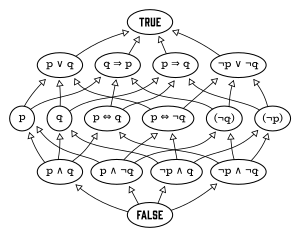
In abstract algebra, a Boolean algebra or Boolean lattice is a complemented distributive lattice. This type of algebraic structure captures essential properties of both set operations and logic operations. A Boolean algebra can be seen as a generalization of a power set algebra or a field of sets, or its elements can be viewed as generalized truth values. It is also a special case of a De Morgan algebra and a Kleene algebra.

In mathematics, cardinal numbers, or cardinals for short, are a generalization of the natural numbers used to measure the cardinality (size) of sets. The cardinality of a finite set is a natural number: the number of elements in the set. The transfinite cardinal numbers, often denoted using the Hebrew symbol (aleph) followed by a subscript, describe the sizes of infinite sets.
In mathematics, specifically category theory, a functor is a mapping between categories. Functors were first considered in algebraic topology, where algebraic objects are associated to topological spaces, and maps between these algebraic objects are associated to continuous maps between spaces. Nowadays, functors are used throughout modern mathematics to relate various categories. Thus, functors are important in all areas within mathematics to which category theory is applied.

In mathematics, the power set of a set S is the set of all subsets of S, including the empty set and S itself. In axiomatic set theory, the existence of the power set of any set is postulated by the axiom of power set. The powerset of S is variously denoted as P(S), 𝒫(S), P(S), , , or 2S. The notation 2S, meaning the set of all functions from S to a given set of two elements, is used because the powerset of S can be identified with, equivalent to, or bijective to the set of all the functions from S to the given two elements set.
In mathematics, a complete lattice is a partially ordered set in which all subsets have both a supremum (join) and an infimum (meet). A lattice which satisfies at least one of these properties is known as a conditionally complete lattice. Specifically, every non-empty finite lattice is complete. Complete lattices appear in many applications in mathematics and computer science. Being a special instance of lattices, they are studied both in order theory and universal algebra.

In mathematics, the free groupFS over a given set S consists of all words that can be built from members of S, considering two words to be different unless their equality follows from the group axioms. The members of S are called generators of FS, and the number of generators is the rank of the free group. An arbitrary group G is called free if it is isomorphic to FS for some subset S of G, that is, if there is a subset S of G such that every element of G can be written in exactly one way as a product of finitely many elements of S and their inverses.

In mathematics, particularly in set theory, the aleph numbers are a sequence of numbers used to represent the cardinality of infinite sets that can be well-ordered. They were introduced by the mathematician Georg Cantor and are named after the symbol he used to denote them, the Hebrew letter aleph.
In mathematics, the idea of a free object is one of the basic concepts of abstract algebra. Informally, a free object over a set A can be thought of as being a "generic" algebraic structure over A: the only equations that hold between elements of the free object are those that follow from the defining axioms of the algebraic structure. Examples include free groups, tensor algebras, or free lattices.
In mathematics, particularly in algebra, the class of projective modules enlarges the class of free modules over a ring, by keeping some of the main properties of free modules. Various equivalent characterizations of these modules appear below.
In mathematics, a join-semilattice is a partially ordered set that has a join for any nonempty finite subset. Dually, a meet-semilattice is a partially ordered set which has a meet for any nonempty finite subset. Every join-semilattice is a meet-semilattice in the inverse order and vice versa.
In universal algebra, a variety of algebras or equational class is the class of all algebraic structures of a given signature satisfying a given set of identities. For example, the groups form a variety of algebras, as do the abelian groups, the rings, the monoids etc. According to Birkhoff's theorem, a class of algebraic structures of the same signature is a variety if and only if it is closed under the taking of homomorphic images, subalgebras and (direct) products. In the context of category theory, a variety of algebras, together with its homomorphisms, forms a category; these are usually called finitary algebraic categories.
In mathematics, a real closed field is a field F that has the same first-order properties as the field of real numbers. Some examples are the field of real numbers, the field of real algebraic numbers, and the field of hyperreal numbers.
In commutative algebra and field theory, the Frobenius endomorphism is a special endomorphism of commutative rings with prime characteristic p, an important class which includes finite fields. The endomorphism maps every element to its p-th power. In certain contexts it is an automorphism, but this is not true in general.
In the mathematical field of set theory, Martin's axiom, introduced by Donald A. Martin and Robert M. Solovay, is a statement that is independent of the usual axioms of ZFC set theory. It is implied by the continuum hypothesis, but it is consistent with ZFC and the negation of the continuum hypothesis. Informally, it says that all cardinals less than the cardinality of the continuum, , behave roughly like . The intuition behind this can be understood by studying the proof of the Rasiowa–Sikorski lemma. It is a principle that is used to control certain forcing arguments.
In mathematics, a complete Boolean algebra is a Boolean algebra in which every subset has a supremum. Complete Boolean algebras are used to construct Boolean-valued models of set theory in the theory of forcing. Every Boolean algebra A has an essentially unique completion, which is a complete Boolean algebra containing A such that every element is the supremum of some subset of A. As a partially ordered set, this completion of A is the Dedekind–MacNeille completion.
Boolean algebra is a mathematically rich branch of abstract algebra. Stanford Encyclopaedia of Philosophy defines Boolean algebra as 'the algebra of two-valued logic with only sentential connectives, or equivalently of algebras of sets under union and complementation.' Just as group theory deals with groups, and linear algebra with vector spaces, Boolean algebras are models of the equational theory of the two values 0 and 1. Common to Boolean algebras, groups, and vector spaces is the notion of an algebraic structure, a set closed under some operations satisfying certain equations.
In mathematics, the congruence lattice problem asks whether every algebraic distributive lattice is isomorphic to the congruence lattice of some other lattice. The problem was posed by Robert P. Dilworth, and for many years it was one of the most famous and long-standing open problems in lattice theory; it had a deep impact on the development of lattice theory itself. The conjecture that every distributive lattice is a congruence lattice is true for all distributive lattices with at most ℵ1 compact elements, but F. Wehrung provided a counterexample for distributive lattices with ℵ2 compact elements using a construction based on Kuratowski's free set theorem.
In mathematics, a cardinal function is a function that returns cardinal numbers.
The theory of accessible categories is a part of mathematics, specifically of category theory. It attempts to describe categories in terms of the "size" of the operations needed to generate their objects.
This is a glossary of set theory.









